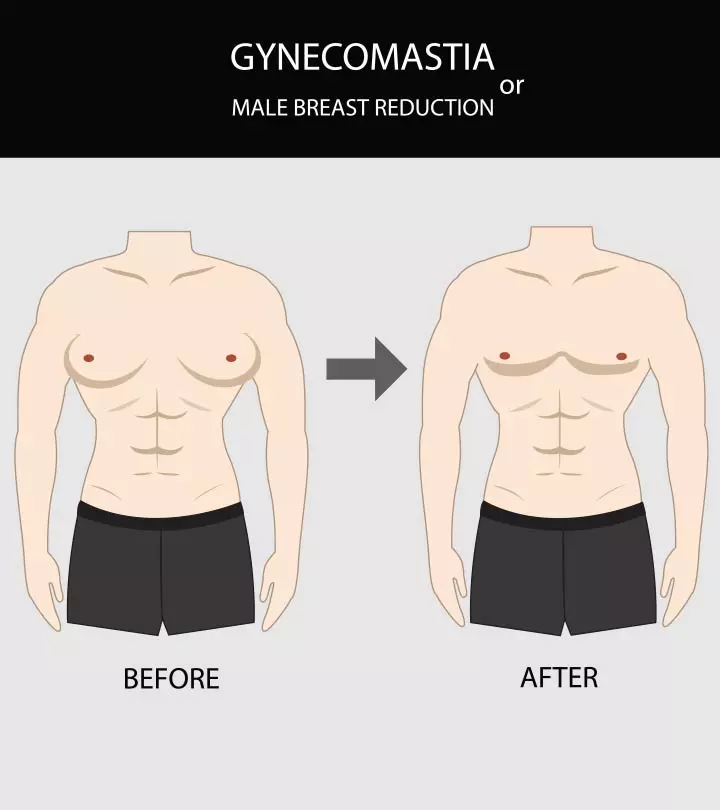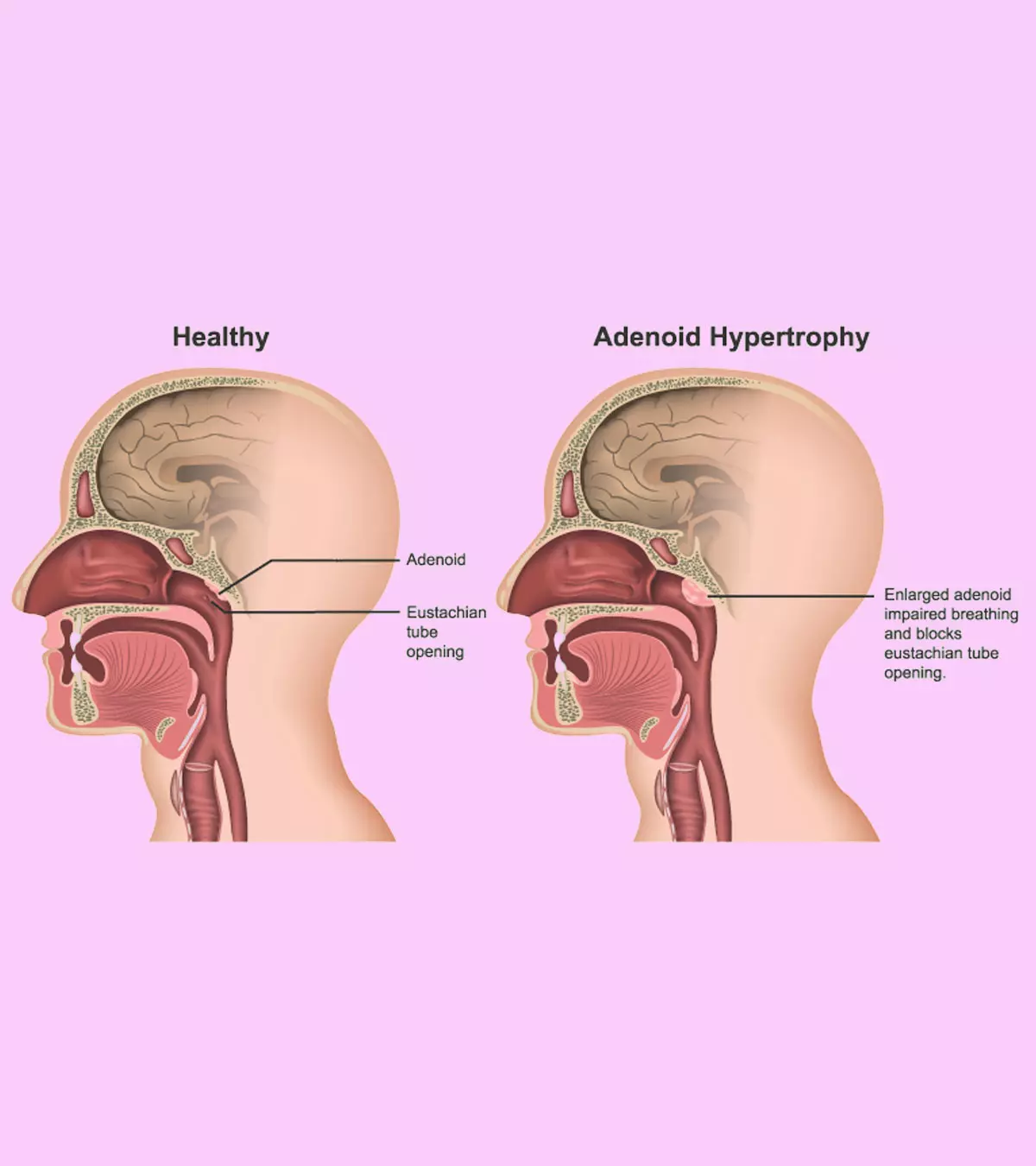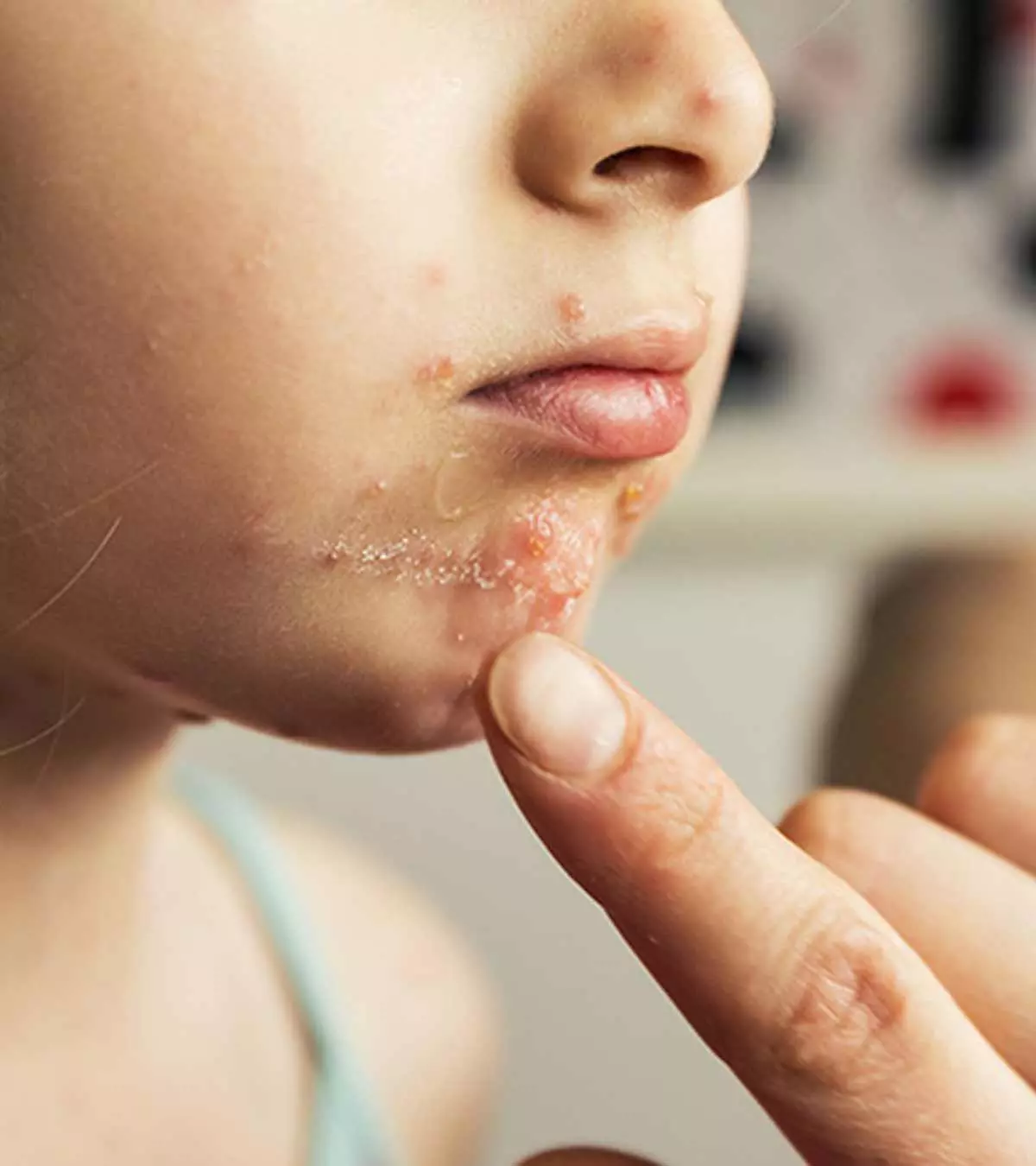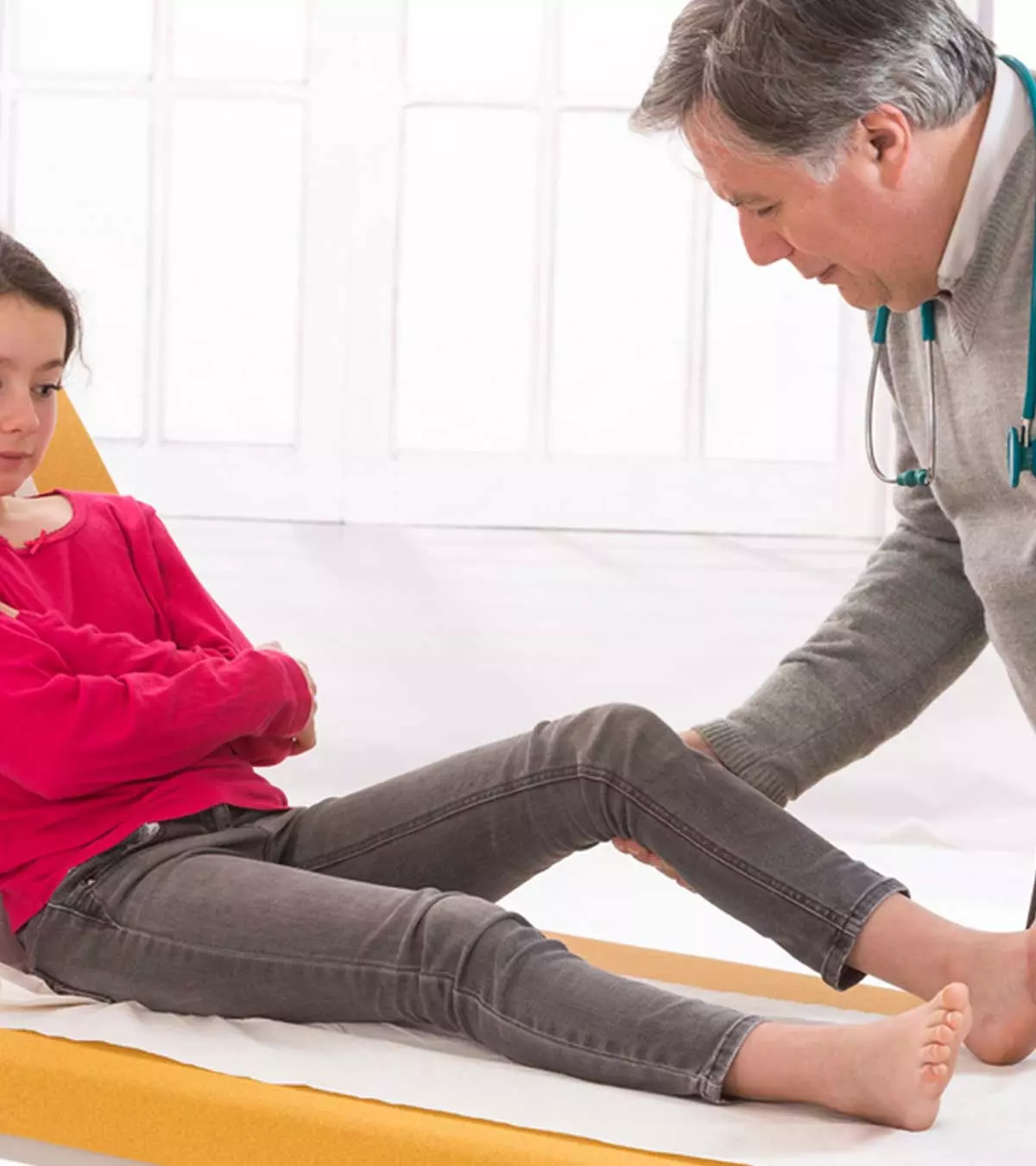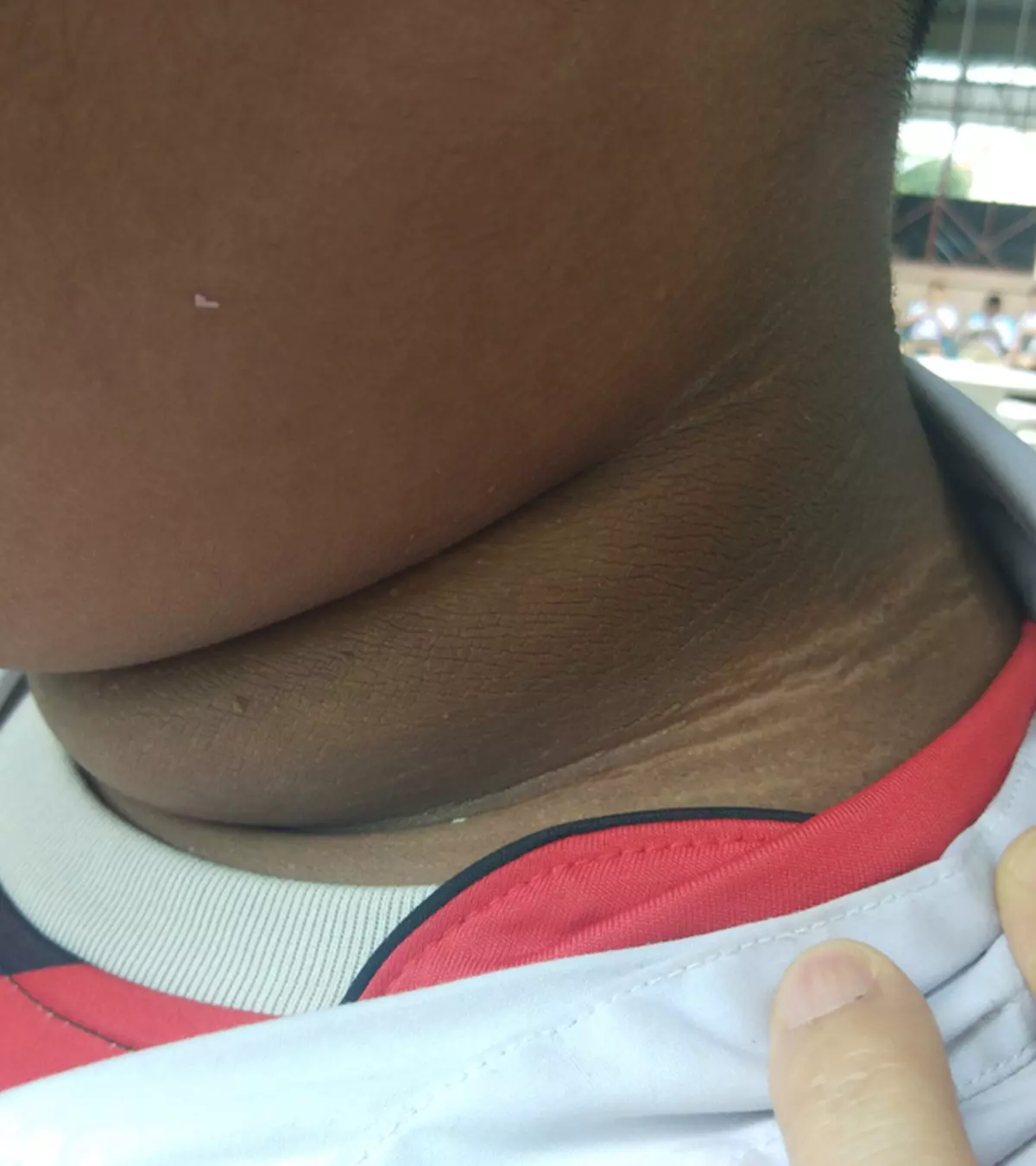
Image: ShutterStock
Acanthosis nigricans (AN) in kids often indicate increased blood insulin levels. This condition causes dry and dark patches or streaks of skin on the neck, underarms, and groins. It is often seen in individuals with diabetes and obesity (1). Although it may cause mild itching, AN is usually harmless and not contagious. According to the American Diabetes Association, acanthosis nigricans indicates insulin resistance and diabetes mellitus in children in preteen years (2) (3). Read on to know more about the causes, treatment, and ways to prevent acanthosis nigricans in children.
Key Pointers
- Acanthosis nigricans (AN) is a skin condition commonly found in preteens that is associated with increased insulin and diabetes.
- AN can be caused by either insulin inheritance or it may be hereditary.
- Symptoms of AN can be observed as hyperpigmentation and thickening of the skin in the form of black streaks, rough, and velvety lines.
- The condition can be treated with medications for underlying conditions as well as topical treatments.
- AN can be prevented by reducing sugar intake, maintaining a balanced diet, engaging in regular exercise, and managing weight.
Symptoms Of Acanthosis Nigricans In Children
AN in children is common among adolescents and teens. The symptoms are mostly subtle and often go unnoticed. However, they can lead to psychological effects; children may experience teasing or bullying due to the skin’s appearance, which can affect their self-esteem. Here are a few indicators to identify AN in your child (4) (5).
- Symmetrical darkening (hyperpigmentation) and thickening (hyperkeratosis) of the skin.
- Streaks of black lines which are dark and have a roughened and velvety texture.
- No pain or discomfort, but might occasionally itch.
- The skin around these areas may look rough and dark. In particular, for individuals with darker phenotypes, the AN may appear darker and leathery (9).
- It commonly occurs around the folds on the skin, such as the neck, underarms, back of the knees, joints of the fingers, and inner thighs. It may also occur in the groin region.
- Less frequently, it might occur on the eyelids, face, palms, soles, and nipples.
 Quick fact
Quick factPictures Of Acanthosis Nigricans In Children
Pigmentation on the skin may also be due to sunburn or nutrient deficiency. Thus, it is necessary to identify the symptoms of AN. Here are a few pictures that might help.
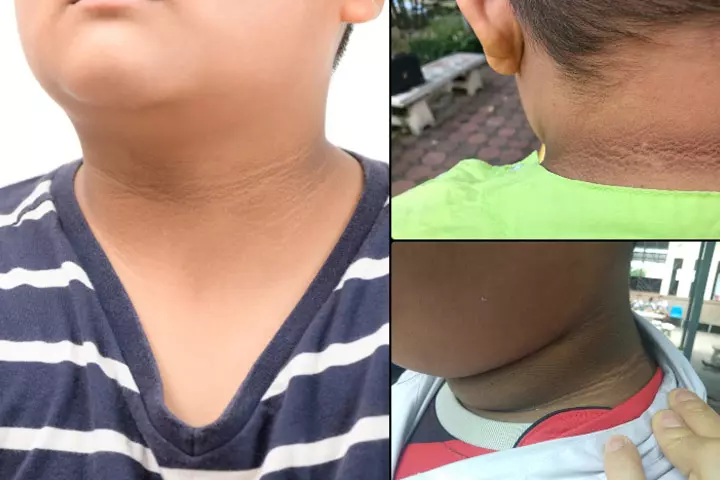
Possible Causes Of Acanthosis Nigricans In Children
Here are some of the reasons why children could develop dark patches around the neck.
1. Insulin resistance

This is the most common reason for AN. The insulin hormone, secreted by the pancreas, helps the cells use glucose from the bloodstream. During insulin resistance, cells are unable to use insulin for glucose permeability as they possess low insulin sensitivity. It leads to excess insulin and glucose in the bloodstream. Insulin resistance may occur due to several health conditions. Obesity or being overweight is one of the significant factors for developing insulin resistance.
Insulin resistance can lead to hyperpigmentation and thickening of the epidermal skin cells, resulting in insulin resistance-associated acanthosis nigricans (6). In fact, the visibility of AN in areas in addition to the neck, such as on the knuckles, dorsal hands, and dorsal feet, could be considered as the early manifestation of insulin resistance. Additionally, resistance to insulin increases the risk of type II diabetes which is yet another cause or risk factor associated with the appearance of AN in kids (15).
2. Heredity
A rare form of AN known as unilateral acanthosis nigricans can occur in a child with a family history of AN. This is characterized by the appearance of lines over the face, chest, scalp, abdomen, back, and thighs. This type of AN may not indicate an underlying endocrine disorder (7).
3. Other causes
Long-term usage of medicines, such as oral contraceptive pills or artificial human growth hormones may cause AN. Rarely, AN could be a symptom of lymphomaiCancer of the lymphatic system, the body’s defense system, that can be environmentally or genetically induced. or cancers associated with the gastrointestinal or genitourinary tractiThe system that includes all the organs of the urinary system and the genitals. (8) (9). Additionally, some autoimmune disorders, such as systemic lupus erythematosusiAn autoimmune condition when the body's immune system attacks its own tissues. , sclerodermaiA rare condition that thickens skin and tissues throughout the body due to the excess production of collagen. , and Hashimoto's thyroiditisiAn autoimmune condition that affects the thyroid gland, causing hypothyroidism or underactive thyroid. , can also cause AN in kids. These are rare types of AN (9).
 Point to consider
Point to considerWho Are At A Higher Risk Of Developing Acanthosis Nigricans?
Not all children develop acanthosis nigricans; here are some of the risk factors which might increase the chances of developing AN in children.
- Obesity: Acanthosis nigricans is usually more common among obese children. Studies note that obesity causes a significant accumulation of visceral fat (fat around the abdominal organs) and reduced subcutaneous fat (fat under the skin). This change in the deposition of the fat could affect the way cells use insulin, and, thus, increase the risk of insulin resistance and, eventually, AN (10). A cross-sectional study by multiple institutes involving 4,023 children between two and eight years investigated the prevalence of AN among them. The study revealed that around five percent of the participants exhibited symptoms of AN. Also, the prevalence of obesity was higher among boys (15.8%) than girls (10.8%) (16).

- Hormonal problems: Children with hormonal problems or imbalances may be at a higher risk of developing AN. A few examples of hormonal problems that may increase the risk of AN are hypothyroidism (underactive thyroid gland), polycystic ovary syndromeiA condition where the female body produces increased male hormone resulting in multiple cysts on the ovaries. , and Cushing’s syndromeiHormonal disorder caused by excessive amounts of cortisol or the stress hormone in the blood. (1).
Pamela Vireday, a childbirth educator, author, speaker, and mother to four children, shares about her younger son’s condition. She says, “I’m even more worried and sad for my younger son (who is just hitting puberty) because he likely won’t meet the height-weight guidelines unless his upcoming growth spurt changes something drastically. He was always an average-sized kid until shortly before puberty, when his weight suddenly increased drastically. You can see that he has very strong insulin resistance because he has acanthosis nigricans (darkened skin around his neck and armpits) and lots of skin tags. I think he has the male version of my PCOS (i).”
Diagnosis Of Acanthosis Nigricans
A doctor can diagnose AN through physical examination of the affected skin. BMI and body weight may be checked to determine if the child is overweight or obese. Screening of blood and urine samples could help determine the underlying cause, such as insulin resistance, hormonal imbalances, etc.
In rare cases, a small sample of the thickened skin ( skin biopsy) may be collected for lab analysis. Parents should inform the doctor about any prescription medications, supplements, vitamins their child is taking before commencing treatment (5).
 Did you know?
Did you know?Treatment For Acanthosis Nigricans In Children
The treatment of AN can be either treating the underlying cause or topical treatments for the dark patches.
Treating the underlying cause
- If your doctor has diagnosed obesity as the cause, then they would prescribe exercises and diet to help your child reduce their weight. If obesity is due to an underlying medical condition, such as hypothyroidism, then medications would be prescribed to control it.
- Medications to keep the blood sugar under control could be prescribed if the child has insulin resistance or type II diabetes.
- Discontinuing medicines that caused AN and prescribing alternative medications could also be advised (11).
- If AN is associated with a tumor, the removal or treatment of the tumor can resolve the AN completely (17).
Topical treatments
- Topical retinoid creams could be used to reduce the pigmentation in the various areas of the skin (consult your doctor if you could apply these in the genital areas).
- Topical vitamin creams, such as vitamin D analog cream, might be helpful in some cases (11).
Once the underlying cause is treated or managed, the dark and thick streaks fade away. Cosmetic treatment methods, such as laser treatment and skin peels, are not recommended for children. However, in addition to medical treatments, psychological support may be beneficial for children dealing with the social implications of acanthosis nigricans. Counseling can help children cope with any emotional distress related to their condition.
Can You Prevent Acanthosis Nigricans In Children?
Prevention of Acanthosis Nigricans in kids depends on preventing the underlying cause. If your family has a history of obesity or diabetes, then follow these precautions to reduce the child’s risk of insulin resistance and AN (18).
- Control the intake of sugars and refined flour by your children. Do not let them binge eat candies, muffins, pastries, high-sugar drinks, and processed foods.
- Provide a healthy balanced diet rich in fruits, vegetables, and fiber.
- Encourage your child to exercise daily. You can let them participate in sports or outdoor games.
- Monitor their weight and make sure they are within the prescribed ranges.
- Encourage them to drink plenty of water.
These strategies will effectively help your child reduce the amount of unused insulin in their body, lowering the risk of AN (18). If your child has any other condition, such as hypothyroidism, then follow the appropriate treatment prescribed by the doctor.
Frequently Asked Questions
1. Can puberty cause acanthosis nigricans?
While there is no direct association between puberty and acanthosis nigricans, children may develop acanthosis nigricans due to pubertal changes because of the fluctuations in hormone levels and obesity (12).
2. Do acanthosis nigricans spread in children?
No, acanthosis nigricans cannot spread to other individuals or other parts of the body (13).
3. Is acanthosis nigricans a fungus?
No. Acanthosis nigricans is not a fungal infection; however, a study showed that nigricans with severe papillomatosis are susceptible to developing fungal infections (14).
4. Can you wash off acanthosis nigricans in children?
No. Acanthosis nigricans in kids might look like a dirty skin area, but it cannot be washed off. Instead, lifestyle changes, including regular physical activity, a healthy diet, and weight control can help improve a child’s skin health and pigmentation.
Acanthosis nigricans in kids is a symptom and points towards some underlying issues. These include problems such as metabolic syndrome, which further leads to obesity, raised blood pressure, abnormal lipids levels, and increased cholesterol. The issue indicates that the child has a higher chance of developing diabetes, heart disease, and stroke later. Therefore, it is essential to bring the problem to control at the earliest. You must visit your child’s doctor and begin treatment well within time to avoid further complications.
Infographic: Facts About Acanthosis Nigricans In Children
Acanthosis nigricans in children can be due to various reasons. Lifestyle and dietary modifications may help some children get rid of it. However, a few children may require additional medications and evaluations from their pediatrician. Go through the infographic to learn more facts about acanthosis nigricans in children. Illustration: Momjunction Design Team
Acanthosis Nigricans is a harmless skin condition characterized by dark patches on the skin. Discover the solutions through simple lifestyle adjustments and natural cures. This video offers insights on diet, exercise, and more!
Personal Experience: Source
MomJunction articles include first-hand experiences to provide you with better insights through real-life narratives. Here are the sources of personal accounts referenced in this article.
i. One Little Pound: Boy Scouts and Arbitrary Weight Limits; My Own Kids;https://wellroundedmama.blogspot.com/2013/07/one-little-pound-boy-scouts-and.html
References
- Acanthosis nigricans; NHS UK
- TM Nithun, P. S. S Ranugha, Jayadev B Betkerur, Veeranna Shastry;Association of acanthosis Nigricans and insulin resistance in indian children and youth – A HOMA2-IR based cross-sectional study; Indian Dermatology Online Journal
- About Diabetes Common Terms; American Diabetes Association
- Acanthosis Nigricans; Nemours KidsHealth
- Hak Yung Ng; Acanthosis nigricans in obese adolescents: prevalence, impact, and management challenges; NCBI
- Young Kwon Koh, Jae Hee Lee, Eun Young Kim, and Kyung Rye Moon; Acanthosis Nigricans as a Clinical Predictor of Insulin Resistance in Obese Children; Pediatric Gastroenterology Hepatology and Nutrition
- Meghana Madhukar Phiske; An approach to acanthosis nigricans; Indian Dermatology Online Journal
- ACANTHOSIS NIGRICANS: WHO GETS AND CAUSES; American Academy of Dermatology Association
- Acanthosis Nigricans; DermNet
- Alan R. Sinaiko, Sonia Caprio; Insulin Resistance; NCBI
- Nupur U Patel, et al.; Current treatment options for acanthosis nigricans; NCBI
- Christine M. Burt Solorzano and Christopher R. McCartney; Obesity and the pubertal transition in girls and boys; NCBI
- Acanthosis Nigricans; Cleveland Clinic
- Jung JW et al.; Relationship Between Acanthosis Nigricans and Fungal Infection: Clinical and Histopathological findings; Journal of mycology and infection
- Samara Pollock et al.; Acanthosis nigricans in the pediatric population: a narrative review of the current approach to management in primary care; Pediatric medicine
- Ashley B. Yamanaka et al.; Determination of Child Waist Circumference Cut Points for Metabolic Risk Based on Acanthosis Nigricans, the Children’s Healthy Living Program; Preventing Chronic Disease; CDC (2021)
- Evelyn K. Hughes et al.; Acanthosis Nigricans; StatPearls; NIH
- Acanthosis Nigricans; Nationwide Children’s Hospital
Community Experiences
Join the conversation and become a part of our nurturing community! Share your stories, experiences, and insights to connect with fellow parents.
Read full bio of Dr. Neema Shrestha
Read full bio of Dr Bisny T. Joseph
Read full bio of Swati Patwal
Read full bio of Anindita Ghatak







